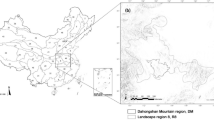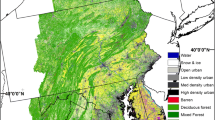ABSTRACT
We analyzed the spatial heterogeneity in vegetation indices among 13 North American landscapes by using full Landsat Thematic Mapper images. Landscapes varied broadly in the statistical distribution of vegetation indices, but were successfully ordinated by using a measure of central tendency (the mean) and a measure of dispersion (the standard deviation or the coefficient of variation). Differences in heterogeneity among landscapes were explained by their topographic relief and their land cover. Landscape heterogeneity (standard deviation of the Normalized Difference Vegetation Index, NDVI) tended to increase linearly with topographic relief (standard deviation of elevation), but landscapes with low relief were much more heterogeneous than expected from this relationship. The latter were characterized by a large proportion of agricultural land. Percent agriculture, in turn, was inversely related to topographic relief. The strength of these relationships was evaluated against changes in image spatial resolution (grain size). Aggregation of NDVI images to coarser grain size resulted in steady decline of their standard deviation. Although the relationship between landscape heterogeneity and explanatory variables was generally preserved, rates of decrease in heterogeneity with grain size differed among landscapes. A spatial autocorrelation analysis showed that rates of decrease were related to the scale at which pattern is manifested. On one end of the spectrum are agricultural, low-relief landscapes with low spatial autocorrelation and small-scale heterogeneity associated with fields; their heterogeneity decreased sharply as grain size increased. At the other end, desert landscapes were characterized by low small-scale heterogeneity, high spatial autocorrelation, and almost no change in heterogeneity as grain sized was increased—their heterogeneity, associated with land forms, was present at a large scale.
Similar content being viewed by others
Author information
Authors and Affiliations
Additional information
Received 1 October 1997; accepted 11 February 1998.
Rights and permissions
About this article
Cite this article
Riera, J., Magnuson, J., Vande Castle, J. et al. Analysis of Large-Scale Spatial Heterogeneity in Vegetation Indices among North American Landscapes. Ecosystems 1, 268–282 (1998). https://doi.org/10.1007/s100219900021
Issue Date:
DOI: https://doi.org/10.1007/s100219900021




